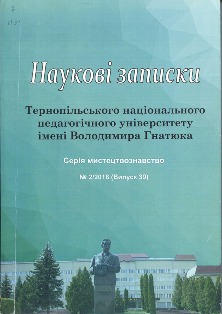АКТУАЛЬНІ АСПЕКТИ ПРОБЛЕМИ ГЕНЕЗИСУ ЗНАКІВ МУЗИЧНОЇ МОВИ
Ключові слова:
музична мова, знак, музична інтонація, жест, музичний рух, інтонаційно-рухова природа музикиАнотація
У статті висвітлено сучасні наукові трактування походження мови в цілому, зокрема, музичної мови, як такої, що має знакову природу. Досліджено єдину природу звукової інтонації та мови людських рухів. Охарактеризовано процес становлення звукової інтонації музичною мовою під час її формування у часі згідно із законами логіки музичного руху. Розглянуто моторно-пластичну сторону музики як одну з найважливіших засад інтонування у психологічно-асоціативній формі.
Посилання
Asaf’ev, B. (1971). Muzykal’naya forma kak protses [Musical form as a process], Book 1 and 2, Leningrad, Music. (in Russian).
Ballonov, L. and Deglin, V. (1976). Slukh i rech dominantnogo i nedominantnogo polushariya [Hearing and speech of the dominant and non-dominant hemisphere], Leningrad, Nauka. (in Russian).
Bart, R. (1975). Basics of semiology, Strukturalizm: “za” i “protiv” [Structuralism: “for” and “against”], Moscow, pp. 114–163. (in Russian).
Belyaevskiy, L. (1987). Instrumental music – the transformation of human movements, Narodnye muzykal’nye instrumenty i instrumental’naya muzyka [Folk musical instruments and instrumental music], Moscow, pp. 106–115. (in Russian).
Bonfel’d, M. (1999). Muzyka: Yazyk. Rech. Myshlenie. Opyt sistemnogo issledovaniya muzykal’nogo iskusstva [Language. Speech Thinking. The experience of the system study of musical art], Vologda, Rus, available at: http://www.booksite.ru/fulltext/bon/fel/bonfeld/01.htm. (in Russian).
Byuler, K. (1993). Teoriya yazyka [Theory of Language], Moscow. (in Russian).
Zhak-Dalkroz, E. (2002). Ritm [Rhythm], Moscow, Klassika-21 vek. (in Russian).
Zaporozhets, A. and Zinchenko, V. (1982). Perception, movement, action, Poznavatel’nye protsessy. Oshchushchenie, vospriyatie [Cognitive processes. Sensation, perception], Moscow, Pedagogika, pp. 50–80. (in Russian).
Zaharov, Yu. (1999). “The interpretation of music: semiotic and hermeneutic aspects”, Thesis abstract for Cand. Sc. (Musical Art), 17.00.02, Moscow, Moscow P. Tchaikovsky State Conservatory, 23 p. (in Russian).
Kagan, M. (1996). Filosofiya kul’tury [Philosophy of Culture], Saint Petersburg. (in Russian).
Kagan, M. (1996). Muzyka v mire iskusstv [Music in the World of Arts], Saint Petersburg. (in Russian).
Koloney, V. (2002). Plastic beginning in the structure of piano performing intonation, Muzichne mistetstvo i kultura. Naukoviy visnyk [Musical art and culture. Scientific Journal], Odesa, pp. 279–286. (in Russian).
Kon, Yu. (1967). To the question of the concept of “musical language”, Ot Lyulli do nashih dney. Sb. Statey [From Lully to our days. Collection of articles], Moscow, Muzyka, pp. 93–104. (in Russian).
Mal’tsev, S. M. (1980). Semantika muzykal’nogo znaka [Semantics of the Musical Sign], Leningrad. (in Russian).
Medushevskiy, V. (1993). Intonatsionnaya forma muzyki : Issledovanie [Intonational form of music: Research], Moscow, Kompozitor. (in Russian).
Medushevskiy, V. (1980). Man in the mirror of intonational form, Sovetskaya muzyika [Soviet Music], no. 9, pp. 34–48. (in Russian).
Moskalenko, V. (1994). Tvorcheskiy aspekt muzyikalnoy interpretatsii (K probleme analiza) [Creative aspect of musical interpretation (On the problem of analysis)], Kyiv, Ministry of Culture of Ukraine, KGK. (in Russian).
Neygauz, G. (1988). Ob iskusstve fortepiannoy igry [About the art of the piano game], 5-th edition, Moscow. (in Russian).
Orlov, G. (1992). Drevo muzyki [The Tree of Music], Washington: Н. L. Frager & Со, St. Petersburg: Sovetskiy kompozitor. (in Russian).
Rappoport, S. (1973). Semiotics and the language of art, Muzyka, iskusstvo i nauka [Music, art and science], Iss. 2, Moscow, pp. 17–58. (in Russian).
Samoylenko, A. (2004). Language of consciousness and semantic analysis of music: to the formulation of the problem, Muzychne mystetstvo i kultura. Naukoviy vIsnik Odeskoyi derzhavnoi muzychnoyi akademii imeni A. V. Nezhdanovoi [Musical art and culture. Scientific Journal of the Odesa A. V. Nezhdanova State Musical Academy], Odesa, pp. 18–29. (in Russian).
Skrebkov, S. (1973). Khudozhestvennye printsipy muzykal’nykh stiley [Artistic principles of musical styles], Moscow. (in Russian).
Sokhor, A. (1971). Theory of musical genres: tasks and prospects, Teoreticheskie problemy muzyikalnykh form i zhanrov. Sb. Statey [Theoretical problems of musical forms and genres. Collection of articles], Moscow, pp. 292–310. (in Russian).
Farbshteyn, A. (1974). Musical aesthetics and semiotics, Problemy muzykalnogo myishleniya. Sb. Statey [Problems of musical thinking. Collection of articles], Moscow, Muzyka, pp. 75–89. (in Russian).
Holopova, V. (1994). Muzyka kak vid iskusstva [Music as a kind of art], Moscow, Scientific creativity Center Conservatria. (in Russian).
Ship, S. (2004). Muzykal’naya rech i yazyk muzyk (Teoret. issled.) [Musical speech and the language of music (Theoretical research.)], Odesa. (in Russian)
Eyzenshteyn , S. (1964). Izbrannye proizvedeniya v 6-ti t. [Selected works in 6 volumes], Vol. 2, Moscow, Iskusstvo. (in Russian).
Yakushin, B. (1984). Gipotezy o proiskhozhdenii yazyka [Hypotheses about the origin of the language], Moscow, Nauka. (in Russian).
Barthes, R. (1975). Image. Music. Text, New York, Hill and Wang, London, Fontana. (in English).
Knepler, G. (1983). Sprache und Musik unter dem Aspekt der Äs-thetik, Sitzungberichte der Akademie der Wissenschaften der DDR [Meeting reports of the Academy of Sciences of the GDR], Berlin, no. 1, pp. 7–34. (in German).

